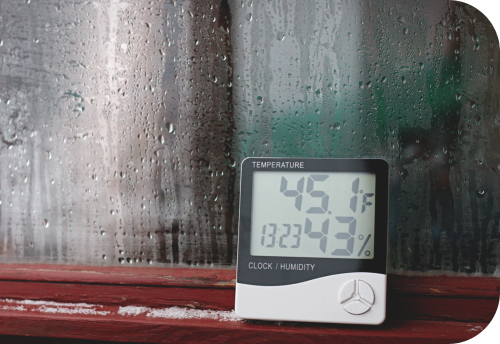Are you curious how to safely humidify your home in the winter? It’s getting to be that time of the year. Temperatures are dropping, and so is the humidity outside, which means people are waking up stuffy and with dry coughs. For Minnesotans with respiratory problems like asthma, an environment that is too dry can actually agitate their respiratory system. Fortunately, a great solution is to set up a humidifier on a nightstand or table to achieve your ideal home humidity level in winter.
But how do you know that you’re properly humidifying your home? Too little, and you won’t experience the full benefits of a humidifier. Too much, and you risk damaging surfaces around the humidifier and developing mold. Here’s how to safely humidify your home in the winter.
When using a humidifier, it’s crucial to use it right and maintain it properly. Otherwise, you may be putting yourself and your family at risk for breathing in harmful bacteria or other particulates dispersed into the air by the humidifier.
The first thing you should know is that a humidifier and a diffuser are two very different things. While some humidifiers have a separate area for essential oils or medicines, you should never put anything besides water in the humidifier’s water reservoir. Pouring anything else in the reservoir may cause buildup in the mechanisms and ultimately ruin the machine or can potentially harm anyone who breathes in the inhalants.
You should also be cleaning the machine and replacing the filter regularly to prevent bacteria from expelling into the air you breathe. When you get a humidifier, take care to keep the owner’s manual handy, as it should have the directions on how to clean it and change the filter listed there. Another way to safely humidify your home in the winter.
Some Minnesota-based homes have a humidifier built into the HVAC system. If that is the case, you simply have to set the level of humidity you desire. If you aren’t certain what your home humidity should be in winter, we recommend between 35-50%. In comparison, it’s not uncommon for the average home humidity level during a Twin Cities area winter to drop to 25-35% — meaning your humidifier can make a huge difference.
We also recommend cleaning humidifiers built into HVAC systems at least once a year. We do not recommend trying to clean out a built-in humidifier yourself because it’s wired into the whole HVAC system. Instead, it’s best to hire a professional. If you’re in the Twin Cities metro area, and have a built-in humidifier, we recommend contacting Kura Home Maintenance at 888-858-5872 or one of the area’s other licensed HVAC service providers.
If you don’t have a humidifier built into your HVAC system, there are portable, cost-effective options available.
When shopping for a humidifier, you’ll find two main types: a cool mist humidifier, and your traditional humidifier that has a warm mist.
As you would expect, a cool mist humidifier expels a steady flow of cool moisture by using a fan to disperse small water particles. A traditional humidifier relies on boiling the water to create steam. If you have kids or pets, you may want to consider purchasing the cool mist, as the traditional version can be a burn hazard and an accident waiting to happen.
Every room is different. Similarly, every humidifier is different. That’s why it’s important to check the specifications listed on the machine to ensure you’re purchasing the right size humidifier for the room you intend to put it in. Otherwise, you may not be able to achieve your ideal home humidity level in the winter months.
Most humidifiers will specify what size room it is good for by the square foot. So, take a tape measure and check the room’s dimensions and base your choice off of the square footage results. If you’re still unsure of what size to get, do a quick internet search for a humidifier sizing chart.
The reason why it’s so crucial you pick the right size is if you choose a machine too big for your room, the moisture output may cause mold growth or damage surfaces around it. Your room humidity level should remain at a healthy 30-50%. Anything higher than 50% creates the perfect environment for mold to grow in your home.
If your home’s humidity has gotten too high and out of control, you want to make sure mold isn’t growing in your residence. If you find yourself with a serious mold problem in your Minneapolis-area home, you can contact Green Clean for certified professional help to restore your home to a healthy and safe environment. That’s why we’re the Right Team, Right Away.
Like us on Facebook
Prev: Best Practice: Who Should You Hire for Testing Pre and Post Restoration?Next: 5 Things to Bring Up to your Insurance Agent on your Annual Review.View All Resources